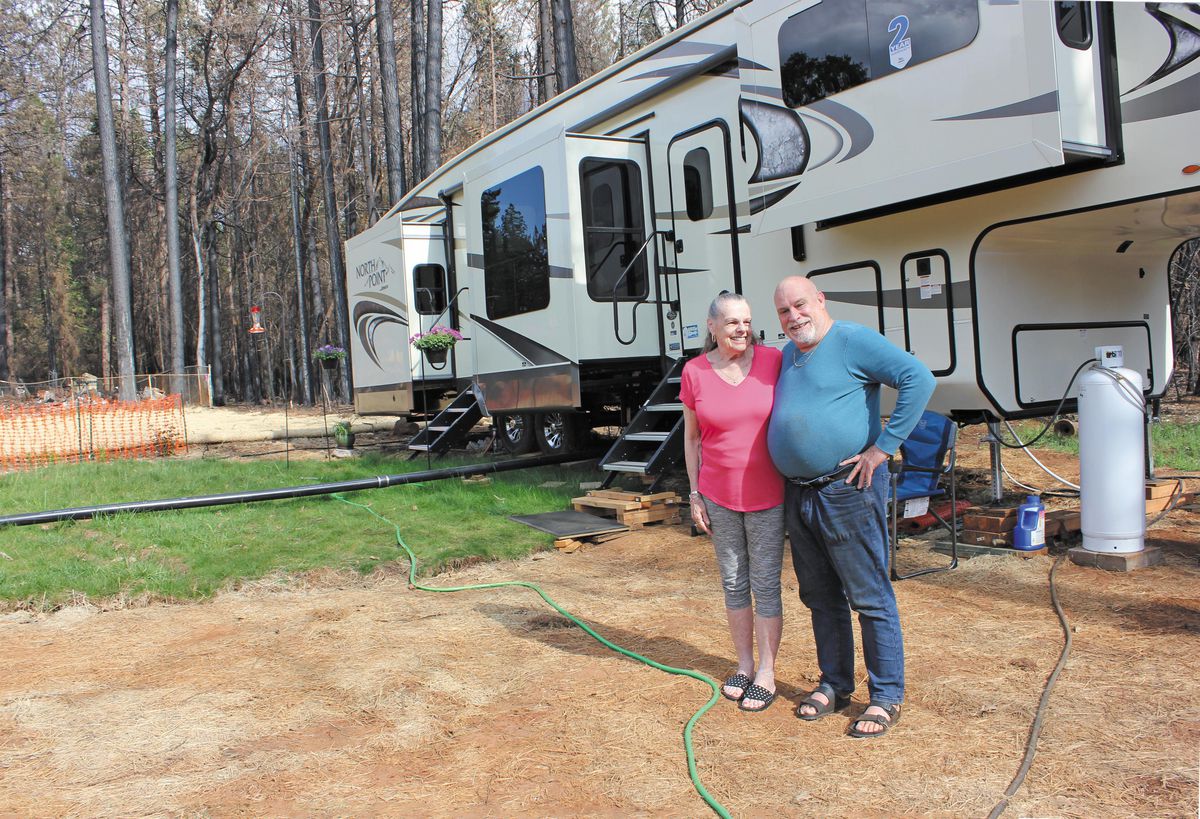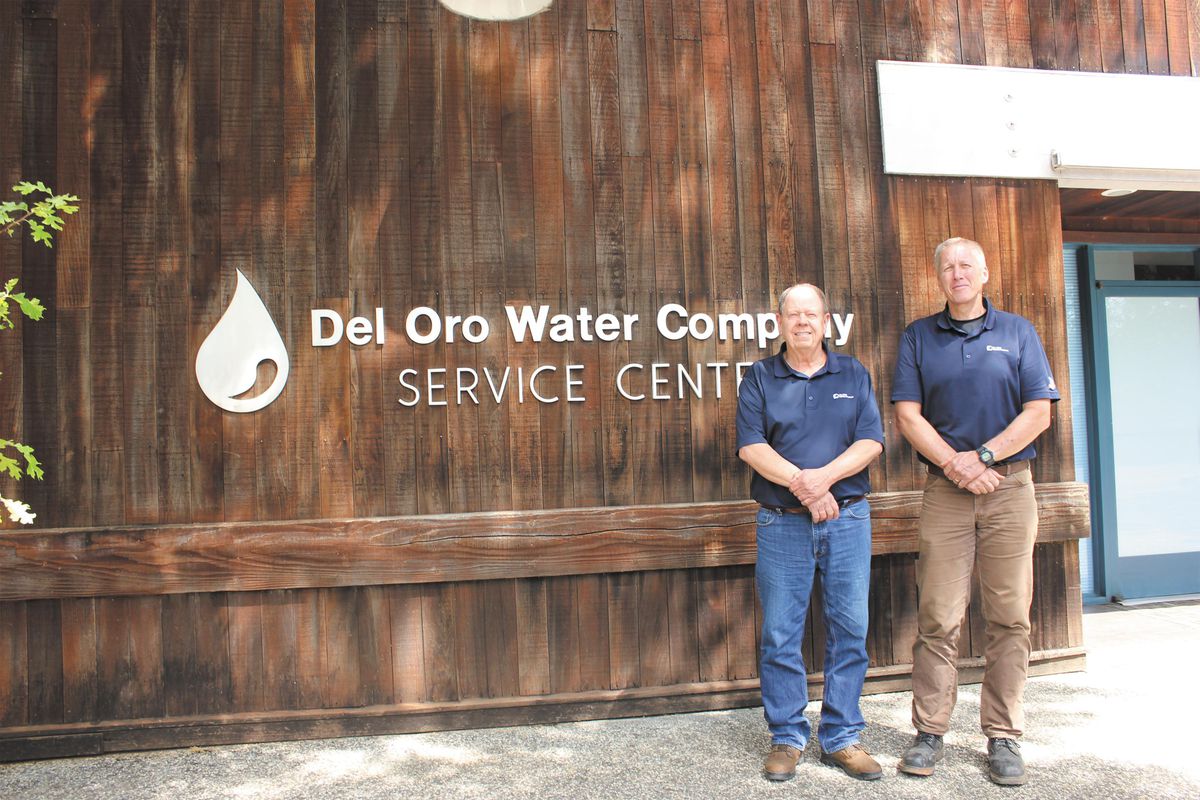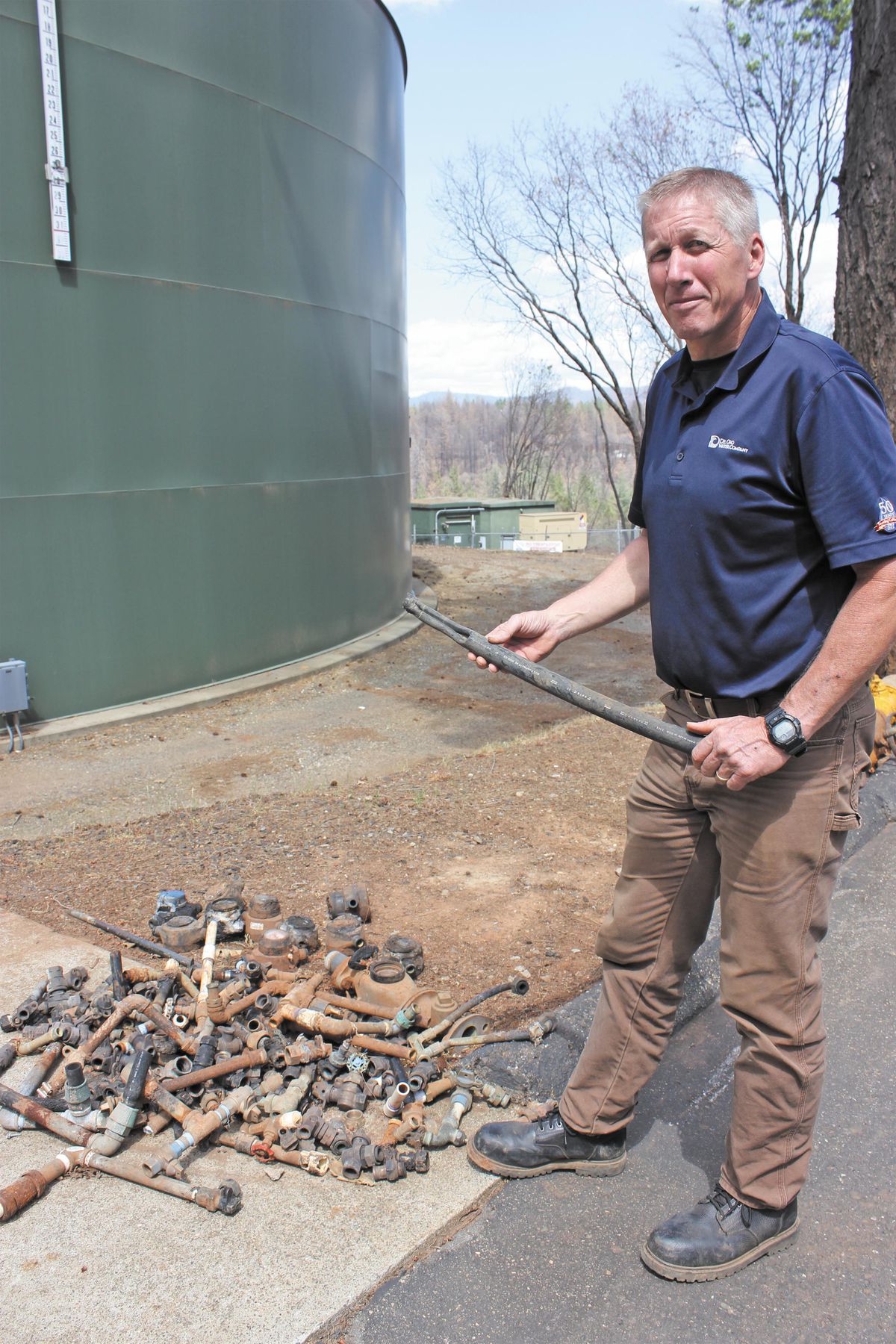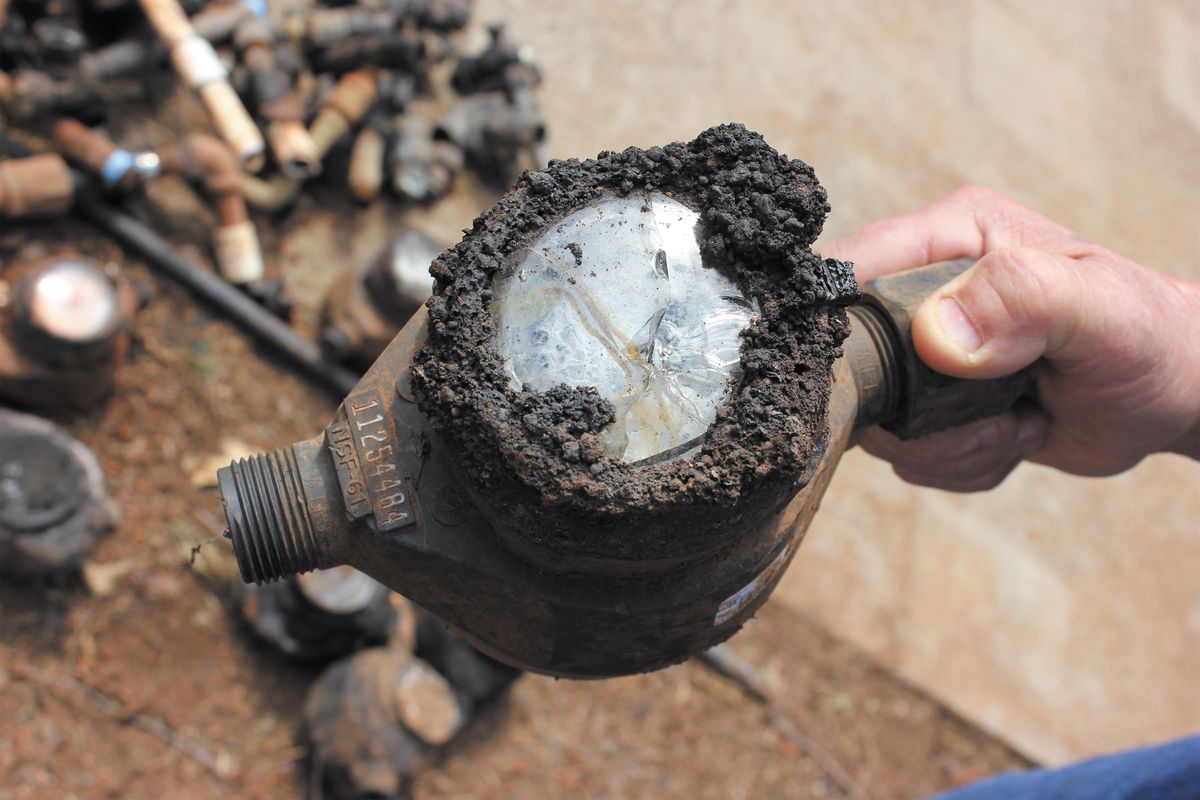
Photo by Meredith J. Cooper
Sherri and Thomas Gardner are eager to rebuild after their home on Ponderosa Way in Magalia burned in the Camp Fire.
Sherri and Thomas Gardner are not concerned that the results of the first water test at their burned-out property in Magalia came back positive for a higher concentration of benzene, a known carcinogen, than the state deems healthy for drinking. After all, a second test came back “ND,” or non-detect.
“The state maximum is 1 part per billion and the feds have theirs at 5—we were dead in the middle at 2.6,” Thomas said last week from the couple’s comfortable RV, which is parked on their now debris-free property. “We’re not at all worried. We’re brushing our teeth with [the water], we’re using it for ice.”
The Gardners are confident because the Del Oro Water Co., their supplier, and the California State Water Resources Control Board, which oversees drinking water regulations, have said that what’s coming out of their faucets is potable. Del Oro has been likewise assured—by the same water board—that its testing methods are sound. But having never grappled with the magnitude of the problem, in which tens of thousands of homes and businesses—and their associated plumbing—burned up, the water board is operating in uncharted territory.
That strikes a nerve with Andrew Whelton, a national expert on large-scale water contamination. He and a team of researchers came to survey the Camp Fire area earlier this year at the request of Paradise Irrigation District (PID), which serves that community. Whelton immediately suggested a few priorities: testing should be broad, health advisories should err on the side of caution, and guidance should be given to the public on how to deal with the problem.
PID is taking his cue, but Del Oro is trusting the state water board, which regulates drinking water to ensure public health. The board issued boil-only notices for both districts immediately following the fire, but only warnings to alert officials of any strange odors after that. Plus, it told the water districts that testing for one contaminant—benzene—is sufficient to determine water safety.
That’s not good enough, says Whelton—the state agency should create and enforce a stringent protocol that’s the same for both districts, he insists.
Whelton started his career over 15 years ago working for the U.S. Army, tasked with studying the implications of a chemical attack on a military base’s water supply and coming up with a response plan. Now, he’s an associate professor of civil engineering and environmental and ecological engineering at Purdue University, and a go-to figure across the country when things like oil spills wreak havoc on drinking water supplies.
Among his criticism related to the Camp Fire, Whelton questions why the water board, which includes the Department of Drinking Water (DDW), has not issued any blanket warnings to residents in the Camp Fire area about the safety of their tap water, nor has it provided adequate, accessible testing protocols. That’s led to inconsistencies when it comes to methodology, which threatens the validity of any testing, as one result can’t reliably be compared with another.
When asked about regulations for water districts to follow in the wake of a natural disaster like the Camp Fire, the CN&R was told such rules don’t exist.
“There are no regulations on how to respond [to a disaster],” said Dan Newton, DDW’s assistant deputy director. For instance, there are testing guidelines, but not requirements. Likewise, there are thresholds for issuing health advisories—but none that exist in the event of unknown contamination.
“We ensure the systems meet the proper standards for delivering drinking water. … We’re ultimately here to support the systems, to assist them with their decisions,” Newton said.
Without a clearly defined roadmap, the two water systems—though addressing similar issues related to the same wildfire—are responding in vastly different ways, from how they’re testing water that already has shown contamination, to issuing health advisories. The result: People in the disaster zone who live 10 minutes apart are receiving conflicting messages from their respective utilities on what to do to protect themselves and their families. Because customers are responsible for the plumbing on their side of the meter, public agencies—from Butte County Public Health to the state water board—are largely leaving them without direction.

Photo by Meredith J. Cooper
John O’Farrell (left) and Jim Roberts are superintendent and assistant superintendent, respectively, of the Del Oro Water Co., which runs four water districts affected by the Camp Fire.
Whelton says the state and county should be leading the way, directing the water districts, as well as residents—including those on wells—on how to best proceed. And, considering the lack of data available to determine the safety of water in the fire-affected areas, they should be treating it as contaminated by default, not the other way around, he says.
“Telling municipalities, or water districts, that they can do whatever they want [following a disaster] doesn’t make any sense to me,” Whelton said. “The process for responding to large-scale drinking water disasters is not new. The causes are new—but responding is not new. People including myself have been involved in these types of disaster responses before.”
With 19 districts across California, Del Oro is a much larger entity than PID. It’s also privately owned—whereas PID is a public agency—which is why it says it’s ineligible for disaster assistance funding through the Federal Emergency Management Agency (FEMA) or California Office of Emergency Services (CalOES). Those agencies are providing monetary aid to PID for water testing and infrastructure repairs.
John O’Farrell has been with Del Oro for 42 years and now serves as superintendent for all 19 districts. Jim Roberts is assistant superintendent, overseeing a handful of districts in the Butte County area, including the four hit by the Camp Fire—two on the Ridge, one that extends south along the Feather River and a fourth on the east side of Chico, in Butte Creek Canyon. He also runs the company’s water treatment facility at Lime Saddle. Like O’Farrell, he’s been with the company for decades—33 years this month. But neither of them has ever experienced anything like what the Camp Fire did to the water system.
“You always think it’s never going to happen,” O’Farrell said.
Both men live in Magalia, so they have skin in the game. Roberts’ home burned in the Camp Fire; O’Farrell’s withstood the blaze. Both remember Nov. 8 clearly and shared their stories during a recent interview in Del Oro’s Magalia office. PG&E had issued a warning the day prior that it might shut off some of its grid due to high winds, Roberts recalled, so he’d sent out an email to the region’s seven-person crew to top off their trucks’ tanks before retiring for the night, anticipating no electricity the following day. That would be one small blessing amid the chaos.
O’Farrell was at the dam in Magalia around 7 a.m. Thursday when he saw what looked like an explosion. “We’ve had fires out in Concow and Highway 70 before, but this one moved so rapidly in our direction,” he recalled.
Del Oro and PID are both gravity-fed systems, so when the fire first struck Paradise, along lower Pentz Road, those service lines suddenly started spewing water, quickly depleting PID’s holding tanks in town while people fled for their lives. Del Oro, in contrast, had a bit more time to prepare, as the fire hit Magalia after Paradise, and much of the destruction there happened Nov. 9.
“We started isolating blocks—streets and neighborhoods—and began shutting them off so we could rebuild storage in our reservoirs,” Roberts said.
“So, the contamination I think Paradise might be dealing with is not as bad here because we didn’t depressurize most of our service lines [like PID did],” O’Farrell added.
Depressurization, or lack of water pressure, creates a vacuum effect, which sucks air—and debris and anything else—back into the system. PID experienced much more severe depressurization than Del Oro, as the fire moved so swiftly through Paradise that personnel didn’t have time to shut off valves.
Del Oro did experience significant losses, however. The Buzztail District in Butte Creek Canyon lost 12 of its 32 service connections; Lime Saddle lost 193 of 385; Magalia 244 of 272; and Paradise Pines 1,779 of 4,697. The company’s overall customer base diminished by 26 percent overnight. (PID lost roughly 90 percent of its connections.)
To mitigate losses, Del Oro sent a letter to customers March 1 outlining a plan to implement a $10.54 monthly “catastrophic wildfire surcharge” across its 19 districts, set to last one year.

Photo by Meredith J. Cooper
Jim Roberts holds a plastic pipe burned during the Camp Fire. It’s believed the plastic in pipes and meters is the source of benzene and other chemical contamination.
“Del Oro Water is under the jurisdiction of the California Public Utilities Commission and with their help the surcharge will cover a portion of our revenue loss until water rates can be revised,” Janice Hanna, director of corporate accounting and regulatory affairs for Del Oro, told the CN&R by email. “Del Oro still has 6,300 customers statewide where PID has [lost] approximately 90% of their customers. Even with the surcharge, Del Oro will be covering at least $400,000 of the [loss] with expenditure cuts.”
Prior to the Tubbs Fire in 2017—which devastated Santa Rosa—there hadn’t been a case of fire causing benzene or other chemicals to leach into water systems. In fact, officials tested for it in that instance only because people began complaining of a strange odor in the water. Then, after discovering the contamination, nobody knew why it was there or how to fix it. While the culprit—plastic pipes and meters—has been identified, officials are still working to fully understand the cause.
“It did not happen in Redding,” said Newton, DDW’s assistant deputy director, referring to the Carr Fire last summer. The consensus is that the combination of the swiftness of the Camp Fire and the depressurization of the water systems caused the contamination, he said.
Depressurization already compromises water systems, by allowing bacteria to enter the pipes. “When the system depressurized, it immediately triggered a boil-water notice,” Newton said. After biological testing concluded the water was free of bacteria, the boil order was lifted. That was Nov. 21. No other health warnings have been triggered through the state, though it did help Del Oro pen a few for its customers.
Newton’s agency has cited the Tubbs Fire as prompting it to call for benzene tests from the get-go. The first tests conducted, however, weren’t until Dec. 5. By then, the evacuation order for portions of Magalia had already been lifted. By mid-month, the entire burn area was reopened to residents. Those tests yielded positive results for benzene.
“When Paradise learned of that, they immediately issued a do-not-drink notice,” Newton said. That notice is still in effect. Del Oro issued no such notice. In fact, a press release from Del Oro dated Jan. 9 states, in all caps, “There is no state mandated order prohibiting customers from drinking Del Oro water at this time.”
Two days later, the state water board issued this statement: “Paradise Irrigation District is advising consumers to use BOTTLED WATER for drinking, food preparation, and brushing teeth; while customers of Del Oro Water Company are being advised that consumers should feel safe drinking their water unless they detect odors reminiscent of plastic or fuel.” (Emphasis theirs.)
While benzene can emit an odor, it doesn’t always, Whelton says. Del Oro’s Roberts and O’Farrell said they were told by the state water board that that test was reliable because the odor of the benzene-contaminated water was so strong in Santa Rosa.
Whelton says that logic is not based in science.
“When we showed up in February, it came to our attention that they were advised to smell the water as part of the determination if there was a problem,” Whelton said. “In the lab, if we have an unknown contaminant, we don’t tell students to go smell it and then test it. We say, ‘Don’t touch it.’”
The smell-test advisory was amended March 5, nearly two months after it was issued.
“As the sources of the contaminants are better understood and further testing is defining the scope and breadth of the issue, the Division is now relying on laboratory results to determine the safety of the water,” reads a DDW release.
Roberts and O’Farrell described their testing methods, as approved by water board personnel: Pipes are required to soak a minimum of 48 hours before a sample is taken. Outside that 48 hours, as crew members are able, they flush the system—send water shooting through it—to try to clear it of any contaminants.

Photo by Meredith J. Cooper
Plastic water meters are the norm, but they were not able to withstand extreme heat during the Camp Fire. Del Oro officials say they plan to put in new plastic meters as residents rebuild and rehook to the water system. In contrast, Paradise Irrigation District is now using a combination of metal and concrete.
“The water board said a 48-hour soak time was adequate,” Roberts said.
Whelton questions where that time frame came from—the standard in Santa Rosa and in the PID area has been 72, he said.
“It is my understanding that the City of Santa Rosa, which experienced water distribution system contamination after the Tubbs Fire, required a 72 hour ‘soak time’ of all infrastructure before water was sampled,” he wrote in a March 11 letter addressed to the DDW’s Reese Crenshaw, who was named by Del Oro officials as their point person but was unavailable to speak with the CN&R. “It is also my understanding that this 72 hour soak time approach was overseen by the DDW and EPA during support to Santa Rosa. The concern at that time was that if a shorter soak time was permitted, any [volatile organic compounds] that were present in the plastics, including benzene (and others which were present), would not have enough time to leach from plastics into water for detection.”
Del Oro also is offering to test standing homes at owners’ request, at cost: $70. That testing involves one sample taken from the kitchen sink, Roberts said, “on the fly,” meaning without any soak time. The test performed at the Gardners’ property also was “on the fly.”
“We want to get an accurate representation from the location used most,” Roberts said.
Another procedure Roberts and O’Farrell said was OK’d by the water board that Whelton says is inadequate: “You can take one water sample at the kitchen faucet, but there’s no evidence that that will predict contamination in your hot water heater—it’s a completely different system,” he told the CN&R back in February (see “Widespread contamination,” Newslines, Feb. 28).
In March, the county issued a warning to anyone living in standing homes in the Camp Fire zone that their houses’ plumbing systems themselves might be contaminated. Del Oro maintains that standing structures in its district are safe.
Since he first came to Butte County to consult on PID’s Camp Fire response, Whelton’s been clamoring for testing to search for more than just benzene. He’s brought his concerns to Del Oro, Butte County Public Health and numerous state agencies. While that chemical is known to be present in plastic plumbing, it’s also an indicator that other potentially hazardous compounds are present. That is why the DDW says its standard is to test for benzene only, Newton said. Whelton doesn’t dispute that the chemical is an indicator, but says it shouldn’t be the sole target of testing, as it doesn’t historically rule out other potentially harmful contamination.
Whelton outlined his argument for wide-panel testing for volatile organic compounds (VOCs) in his letter to Crenshaw: “Specifically, benzene was sometimes ‘not-detected’ (<0.5 ppb) when tert-butyl alcohol (TBA), a VOC, was found above its California drinking water notification level of 12 ppb. TBA is regulated in drinking water by the DDW. Therefore, benzene did not indicate contamination for all regulated VOCs in Santa Rosa.”
Put more bluntly, Whelton told the CN&R: “Not having benzene in the water doesn’t mean you’re safe.” Taking Whelton’s advice, PID is testing for dozens of VOCs and has gotten results above healthy levels for a number of them.
The CN&R learned this week through public records requests that the water board back in December and January received tests results indicating the presence of other toxic chemicals, including lead. The water board dismissed the lead contamination, as testing came up positive only before treatment. (The before and after tests were taken two weeks apart.)
In 2016, Whelton penned an article for online science newsmagazine Undark in which he said he was furious about what was happening in Flint, Mich., where people were poisoned by exposure to lead in their water. He says the sentiment still rings true today.
“Since 2014, my colleagues and I estimate that roughly one million Americans have been provided toxic drinking water at their taps,” he wrote then. “[I]n what has become an epidemic of misinformation, poor testing protocols, and dangerously ignorant, bureaucratically bungled science, they, too were told that their drinking water was safe, only to find out later that it harmed them—or that officials did not really know what chemicals or other toxins were present in the water, despite having first declared it safe.”
He’s still urging government agencies to take charge on behalf of their citizens. The local water districts don’t have the expertise to create protocols, so they need guidance from the state that ensures the protection of the public, Whelton said.
“The failure of the state Water Resources Control Board to equally protect people in Butte County that are served by two different water systems that were affected similarly doesn’t make sense to me,” he said. As for Del Oro, whose customers have been told their water is safe despite tests coming up positive for benzene: “They’re trying their best, I believe, but this is their first time.
“My thought is that they’re trying—but trying’s not good enough because people can still get hurt.”
